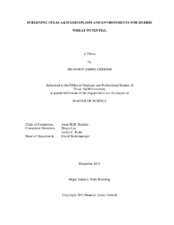| dc.description.abstract | Higher wheat prices, performance potential of hybrids, and the availability of new next generation sequencing has sparked a renewed interest in the development of hybrid wheat. The main advantages of hybrids are higher biomass and yield, longer grain fill periods, enhanced yield stability, vigorous root systems, and increased resistance to biotic and abiotic stresses.
The purpose of this research was to investigate key components that are necessary for a hybrid wheat program. The objectives of this study were to 1) gain a better understanding of the environments and germplasm by utilizing yield data from 2008-2012 advanced variety trials and biplot analysis, 2) determine the contribution of parents in early observation nursery and advanced yield trials by utilizing the existing data from 2009-2012 and 2011-2014 data, respectively, and 3) estimate heterosis and combining ability among a selected set of TAM lines based on phenotypic traits. The third objective was achieved by evaluating the F1 generation from a half-diallel cross for yield and its components in a growth chamber.
The biplot analysis of yield data from 2008-2012 advanced variety trials showed high significant differences amongst environments, varieties, and variety-by-environment interaction. Three mega-environments within Texas were identified and several environments were found to be potentially suitable for hybrid wheat production as they produced high yields each year. ‘Duster’ was found to be the highest yielding and most stable cultivar across environments while ‘Fannin’ was the lowest yielding and unstable. ‘TAM 112’ and ‘TAM 111’ were among the top parental contributors in developing new lines, while ‘Pastor’ had the best mean yield performance among cultivars. The F1 generation from the diallel cross showed significant differences (P<0.05) in all factors of yield and its components. Three of the eight parents (TAM 113, TAM 305, TAM 401) were found to have highly significant (P<0.005) positive general combining ability (GCA) effects for grain yield while three others (TAM 111, TX10D2230, Sturdy 2K) were found to have highly negative GCA effects. In the F2 generation, significant differences (P<0.05) were found for grain yield. None of the parents were found to be significant for GCA. | en |


